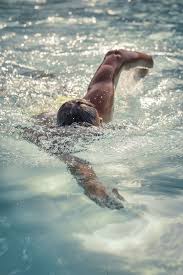Motion sickness and swimming – Suffering from motion sickness and nausea is a fairly common complaint among swimmers, especially in the open water. But it is also possible to suffer from motion sickness in the pool. But why?
One explanation is that you may be excessively moving your head around. Yes it is a technique fault, so it not only is slowing you down and making life more complicated, the additional movement from the head will disturb your internal balance systems, which can quite easily cause nausea or dizziness.
The fix for this is to focus your eyes on a line on the bottom of the pool and concentrate on good posture. The only time this should change is when you go to breathe. The reduced head movement should help you feel more comfortable and help you swim quicker. I know for myself, being excessively sensitive to motion, I am not able to tumble turn in the pool, and even a few minutes practising will cause me minutes of standing poolside to settle my system. This excessive head movement can upset your internal balance system.
When it comes to the open water, where there is no line on the bottom of the sea to follow, you might be attempting to sight more? If the sea is bouncy and you are a bit nervous or anxious, you may be trying to sight more often than you need to, which will disorient you more than it will help. Sighting should occur once every 8-10 strokes – if you have confidence in your straight-line abilities, you could go longer. Sighting more often than this will use far more energy and cause more stress.
Another cause of motion sickness in the water can be a change of pressure in your inner ear. Wearing earplugs should stop water getting in and causing the pressure change. As a result, it can reduce the chances of feeling ill. This was a tip given to me early in my sea swimming days, and it was a saving grace, especially in bouncy water. I was ok when I was swimming but as soon as we stopped and it was bouncy especially if we stopped by a fixed buoy I became nauseated and had to keep swimming. The other advice I was given was to focus on something fixed, in the horizon that was not moving, and then use the distraction of focusing on my technique while swimming both helped when nausea did set in
Dizziness is not uncommon either when you go to get out of the water, especially if open water for a while and going from horizontal to vertical in a short time and then trying to get those legs working in the vertical when all the blood is up in the torso due to the dominant arm demands of swimming. A few tips again are to think about your kicking, so to lessen the effect, in the last 50m of the swim increase your kick action to get more blood flowing to your legs and feet.
If symptoms persist, I would advise seeing further professional advice.[wdi_feed id=”1″]


Leave a Comments
You must be logged in to post a comment.